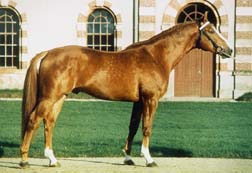Selle Francais
French Saddle Horse
Mon, 25th November, 2024 - 3:30 pm GMT
Sponsor Ads:

Alternative Name
French Saddle HorseBasic Info
Due to its diversified origins conformation can vary. The Selle Français generally has a neat, attractive head, set on to a long neck. The shoulders are usually sloping, the chest is deep and the body is long and muscular. They stand between 15.2 and 17 hands. Chestnut is most common, but can be any color. The Selle Français today continues to be an amagalmation of breeds, with 33 percent from Thoroughbred sires, 20 percent by Anglo-Arab, two percent by French Trotters and 45 percent by Selle Français stallions.
Health
N/AHabitat
N/ABehavior
Use : Competition, riding. Excellent competition horse. Good showjumper, tough, versatile.Origin
FranceHistory
The French have had a long and admired history of horse breeding. Through one of their intensive breeding program has emerged one of the finest sport horses today, the Selle Français or French Saddle Horse. Like all warmbloods the Selle Français is a mix of breeds yet what sets it apart is the influence of crosses with trotting breeds. The breed was developed in the area around the government stud farms of Saint Lô and Le Pin in the French department of Normandy. During the nineteenth century, Norman breeders imported English Thoroughbreds and Norfolk Trotters to cross with their native stock. These crosses resulted in two types of horse: the French Trotter, a fast harness horse and the Anglo-Norman, with both a saddle and draft type. The saddle type of the Anglo-Norman would be the prototype for the modern Selle Français. The Anglo-Norman horse is the most recognized foundation stock for the Selle Français. However, many of the local French breeds which were bred as saddle horses like the Vendeen, Charollais, Limousin, Corlais, Angevin, Angonin and Charentais played an important role in the breeds development. Following World War II, the French began to emphasize the production of a riding horse possessing speed, stamina, and ability. As the Anglo-Norman began to be crossed with the regional breeds the resulting stock began to resemble each other more and more. Because of this growing similarity among the regional breeds they were merged together under one name, "le cheval de Selle Français," meaning the French Saddle horse in 1958. Since then the Selle Français has become the epitome of what a sport horse should be, athletic, strong with good conformation and an intelligent and tractable disposition. The Selle Français has excelled internationally in show jumping. They have also been bred to race as AQPSA (autres que pur sang association, meaning "other than Thoroughbred") and also participate in cross-country racing, dressage and eventing.Common Foods
grassSponsor Ads:
The possible ranks higher than the actual. --Martin Heidegger
Selle Francais
Coded by: BGID® | ALL RIGHTS RESERVED Copyright © 2000-2024
Disclaimer | Privacy | Report Errors / Contact | Credits









 Beware the new Naval power, they are planning to come on stream with big naval might to match their ground forces. Chinese Aircraft Carrier - Chinese Navy
Beware the new Naval power, they are planning to come on stream with big naval might to match their ground forces. Chinese Aircraft Carrier - Chinese Navy  versus
versus 
 versus
versus  This Thread is about the North Korean Military itself - the kind of army, navy, and air force they have.
This Thread is about the North Korean Military itself - the kind of army, navy, and air force they have. 
 versus
versus  versus
versus 
 versus
versus  versus
versus